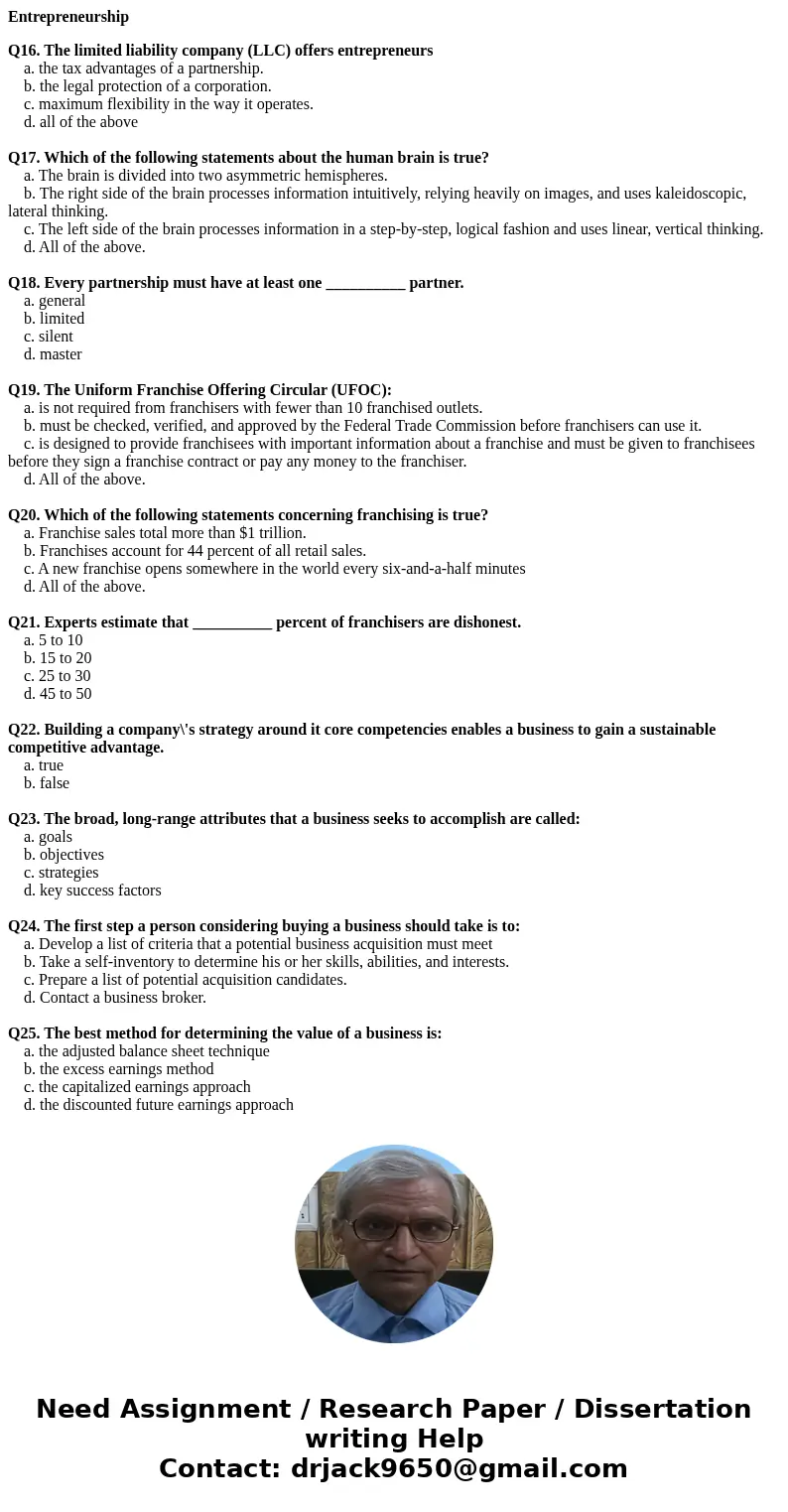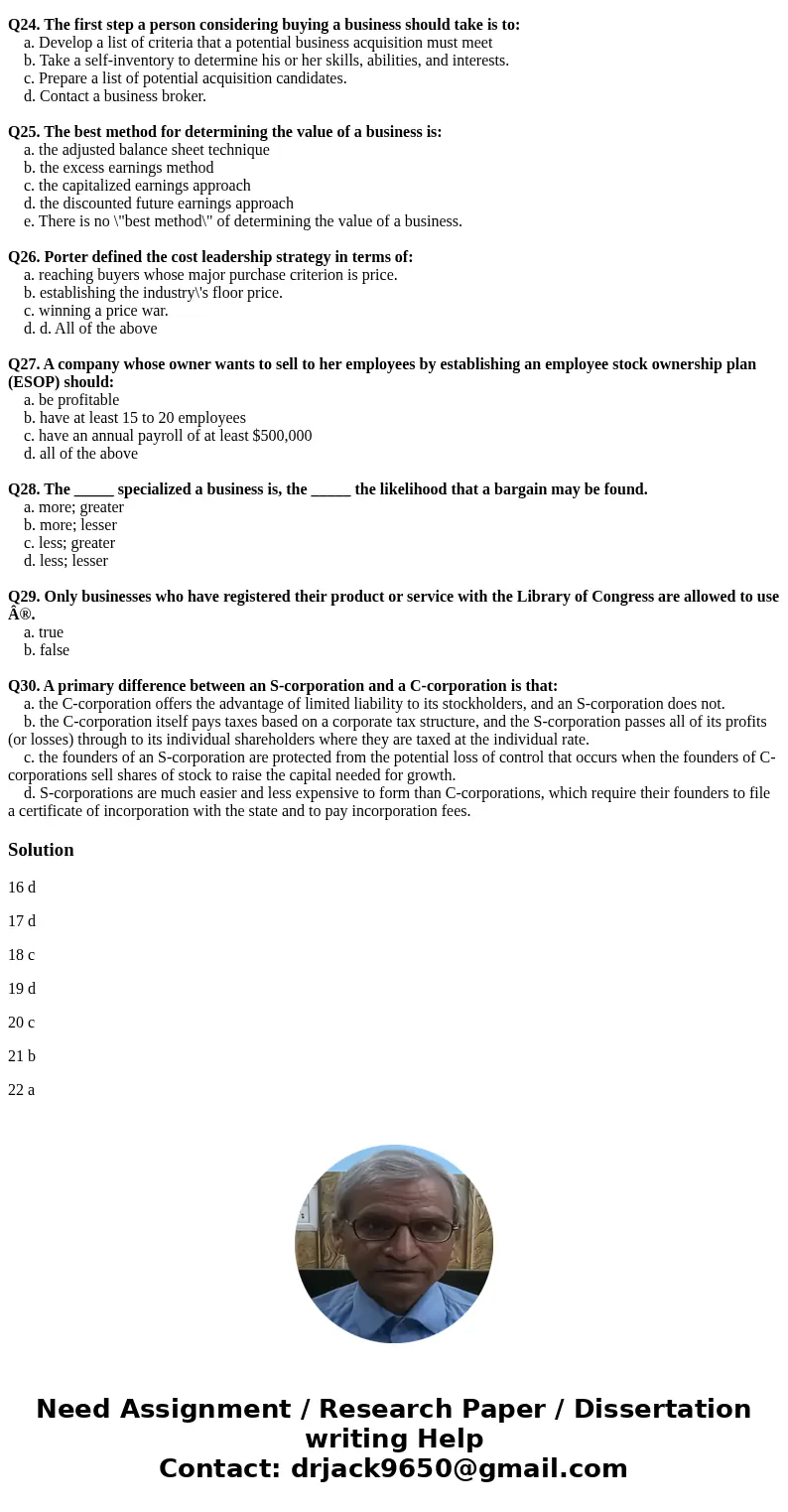Entrepreneurship Q16 The limited liability company LLC offer
Entrepreneurship
Q16. The limited liability company (LLC) offers entrepreneurs
a. the tax advantages of a partnership.
b. the legal protection of a corporation.
c. maximum flexibility in the way it operates.
d. all of the above
Q17. Which of the following statements about the human brain is true?
a. The brain is divided into two asymmetric hemispheres.
b. The right side of the brain processes information intuitively, relying heavily on images, and uses kaleidoscopic, lateral thinking.
c. The left side of the brain processes information in a step-by-step, logical fashion and uses linear, vertical thinking.
d. All of the above.
Q18. Every partnership must have at least one __________ partner.
a. general
b. limited
c. silent
d. master
Q19. The Uniform Franchise Offering Circular (UFOC):
a. is not required from franchisers with fewer than 10 franchised outlets.
b. must be checked, verified, and approved by the Federal Trade Commission before franchisers can use it.
c. is designed to provide franchisees with important information about a franchise and must be given to franchisees before they sign a franchise contract or pay any money to the franchiser.
d. All of the above.
Q20. Which of the following statements concerning franchising is true?
a. Franchise sales total more than $1 trillion.
b. Franchises account for 44 percent of all retail sales.
c. A new franchise opens somewhere in the world every six-and-a-half minutes
d. All of the above.
Q21. Experts estimate that __________ percent of franchisers are dishonest.
a. 5 to 10
b. 15 to 20
c. 25 to 30
d. 45 to 50
Q22. Building a company\'s strategy around it core competencies enables a business to gain a sustainable competitive advantage.
a. true
b. false
Q23. The broad, long-range attributes that a business seeks to accomplish are called:
a. goals
b. objectives
c. strategies
d. key success factors
Q24. The first step a person considering buying a business should take is to:
a. Develop a list of criteria that a potential business acquisition must meet
b. Take a self-inventory to determine his or her skills, abilities, and interests.
c. Prepare a list of potential acquisition candidates.
d. Contact a business broker.
Q25. The best method for determining the value of a business is:
a. the adjusted balance sheet technique
b. the excess earnings method
c. the capitalized earnings approach
d. the discounted future earnings approach
e. There is no \"best method\" of determining the value of a business.
Q26. Porter defined the cost leadership strategy in terms of:
a. reaching buyers whose major purchase criterion is price.
b. establishing the industry\'s floor price.
c. winning a price war.
d. d. All of the above
Q27. A company whose owner wants to sell to her employees by establishing an employee stock ownership plan (ESOP) should:
a. be profitable
b. have at least 15 to 20 employees
c. have an annual payroll of at least $500,000
d. all of the above
Q28. The _____ specialized a business is, the _____ the likelihood that a bargain may be found.
a. more; greater
b. more; lesser
c. less; greater
d. less; lesser
Q29. Only businesses who have registered their product or service with the Library of Congress are allowed to use ®.
a. true
b. false
Q30. A primary difference between an S-corporation and a C-corporation is that:
a. the C-corporation offers the advantage of limited liability to its stockholders, and an S-corporation does not.
b. the C-corporation itself pays taxes based on a corporate tax structure, and the S-corporation passes all of its profits (or losses) through to its individual shareholders where they are taxed at the individual rate.
c. the founders of an S-corporation are protected from the potential loss of control that occurs when the founders of C-corporations sell shares of stock to raise the capital needed for growth.
d. S-corporations are much easier and less expensive to form than C-corporations, which require their founders to file a certificate of incorporation with the state and to pay incorporation fees.
Solution
16 d
17 d
18 c
19 d
20 c
21 b
22 a


 Homework Sourse
Homework Sourse